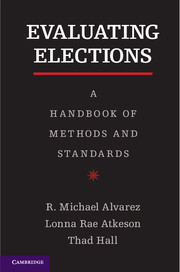Book contents
- Frontmatter
- Contents
- Acknowledgments
- Introduction
- 1 The Electoral Ecosystem
- 2 Easily Available Data for Performance Evaluation
- 3 Measuring the Experiences of Voters
- 4 Measuring the Performance of Poll Workers
- 5 Auditing the Election Ecosystem
- 6 Election Observation
- Conclusion
- Appendix: Precinct Opening, Closing, Election Day Forms
- References
- Index
3 - Measuring the Experiences of Voters
Published online by Cambridge University Press: 05 December 2012
- Frontmatter
- Contents
- Acknowledgments
- Introduction
- 1 The Electoral Ecosystem
- 2 Easily Available Data for Performance Evaluation
- 3 Measuring the Experiences of Voters
- 4 Measuring the Performance of Poll Workers
- 5 Auditing the Election Ecosystem
- 6 Election Observation
- Conclusion
- Appendix: Precinct Opening, Closing, Election Day Forms
- References
- Index
Summary
In today's business world, measurement of the quality of the consumer's experience is essential. Businesses, especially those in areas like retail, spend untold sums of money researching what their consumers want, how they enjoy their shopping experiences, and what new products and services they may want. Think about all the times you have made an online purchase of a product or service and, at the end, you get a request to complete a short survey. In today's busy marketplace, where individuals have many potential outlets for their purchases, corporations are always studying what they can do to make each transaction better.
Although such consumer-oriented research is ubiquitous in the private sector, such tools have not been largely adopted by government entities. This is particularly true for election administrators, who rarely try to obtain systematic feedback from those who are the primary consumers of their services: voters. The other key stakeholders of the services of election officials include candidates running for office, political parties, and voter advocacy groups. Because these groups are generally well-organized, formal entities, they often have structured methods of providing feedback to election officials about the quality of the election-related services they received and the performance of their administrative practices.
- Type
- Chapter
- Information
- Evaluating ElectionsA Handbook of Methods and Standards, pp. 60 - 91Publisher: Cambridge University PressPrint publication year: 2012

